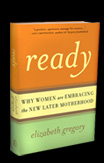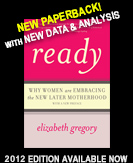About this book • Read an excerpt • read reviews • fast facts
Ready: why women are embracing the new later motherhood
Fast Facts
How many babies are we talking about?
In 2006, of the total 1,697,281 babies born to first-time moms in the United States, 137,674 were born to mothers 35 and over.
• That’s one in every twelve first babies in 2006 with a new later mom.
• Compare that to 1970, when one in every one hundred first babies had a mom 35 or more (that was 14,324 out of total 1,430,680 first births in that year). See Table 4 at CDC.gov (pdf)
Also in 2006, 610,998 babies overall (CDC preliminary count) were born to moms 35 and over—regardless of birth order (out of a total 4,140,419 births).
• That’s one in seven babies born in 2006 to a mom 35 or over.
• In 2004 (latest available data), 4.4% of the births to moms 35 and over involved IVF (about 27,800).
What are some of the benefits of waiting that new later-moms describe?
• Stronger family focus: Having achieved many of their personal and career goals, new later moms feel ready to focus on family. (See chapter two)
• More financial power: New later moms have established careers and make higher salaries. (See chapter three)
• Greater self-confidence: New later moms have more career experience, and their skills translate directly into managing a household and advocating for their children. (See chapters two, three and four)
• More stable single parenting: New later moms who are single have more resources. (See chapter five)
• High marriage rate: On average, 85 percent of new later moms are married, lending stability to the family structure. (See chapter five)
• Peer Marriages: Peer marriages bring together “equal companions” who have similar education levels and job experience and who contribute similarly in all areas within the marriage. (See chapter five)
• Greater likelihood of happiness in marriage: Higher salaries, job skills, and savings create a safety net so that women don’t have to stay in unhappy marriages to avoid impoverishing their kids.
• Longer lives: Evidence indicates that new later moms actually live longer than moms who start their families earlier. (See chapter eight)
Who’s in the study?
113 women are included in the study— three responded to a questionnaire and the rest participated in in-depth interviews. Most women were based in Houston, one corresponded from abroad, and the others live in cities across the United States, including Boston, New York, DC, Chicago, Cincinnati, Dallas, San Francisco, Seattle and Los Angeles. All of the women in the study started their families between the ages of 34 and 56 (though the definition of new later motherhood I’ve employed puts the lower cutoff at 35, six who started their families at 34 insisted that they were part of the trend too).
Eight of those interviewed are black, six are Hispanic, one is Middle Eastern, and the others are Caucasian. Most are married and straight, seven were divorced from the father of their children or have since let me know that they were divorcing, nine were single at the time of their child’s arrival (though three of those had married by the time of the interview), and eight are gay and partnered. A ninth gay couple has since split. At the time of the interview most were the parents of young-to-teenaged children, but several came from the early days of the trend and now have adult children. One was a grandparent.
Seventy-one were working full time, 18 worked part time, 20 were staying at home to raise their kids, either for the long or short term, two were students, one with grown kids had retired at 61, and one was looking for work.
Professions ranged widely and included doctors, lawyers, CEOs, corporate VPs, bankers, artists, teachers, nurses, small business owners, salespeople, architects, politicians, nonprofit executives, journalists, human resource managers, engineers, administrators, IT workers, and more.
About this book • Read an excerpt • read reviews • fast facts



